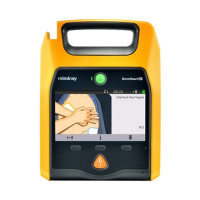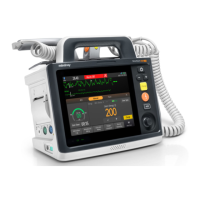4-1
4 Alarms
Alarms, triggered by a vital sign that appears abnormal or by technical problems of the equipment, are indicated to the
user by visual and audible alarm indications.
WARNING
A potential hazard exists if different alarm presets are used for the same or similar device in any single
area, e.g. an intensive care unit or cardiac operating room.
4.1 Alarm Categories
By nature, Pro’s alarms can be classified into two categories: physiological alarms and technical alarms while Public
provides only technical alarms.
1. Physiological alarms
Physiological alarms, also called patient status alarms, are triggered by a monitored parameter value that violates
set alarm limits or by an abnormal patient condition. In AED mode, no physiological alarm will be presented.
2. Technical alarms
Technical alarms, also called system status alarms, are triggered by a device malfunction or a patient data distortion
due to improper operation or system failure.
Alarm messages are displayed in the alarm area.
Apart from the physiological and technical alarms, the equipment also shows some messages indicating system status.
Technically, prompt messages are not alarm messages. Messages of this kind are usually displayed in corresponding
information area. Some special prompts are shown in dialog boxes.
4.2 Alarm Levels
By severity, alarms can be classified into three categories: high level alarms, medium level alarms and low level alarms.
Physiological alarms (For Pro only) Technical alarms
High
level
Indicate that your patient is in a life threatening
situation, such as Asystole, Vfib/Vtac and so forth,
and an emergency treatment is demanded.
Indicate a severe device malfunction or an improper
operation, which could make it possible that the equipment
cannot detect critical patient status or may cause therapy
failed, and thus threaten the patient’s life, such as low battery.
Medium
level
Indicate that your patient’s vital signs appear
abnormal and an immediate treatment is required.
/
Low
level
Indicate that you patient’s vital signs appear
abnormal and an immediate treatment may be
required.
Indicate a device malfunction or an improper operation,
which may compromise a certain function but will not
threaten the patient’s life.

